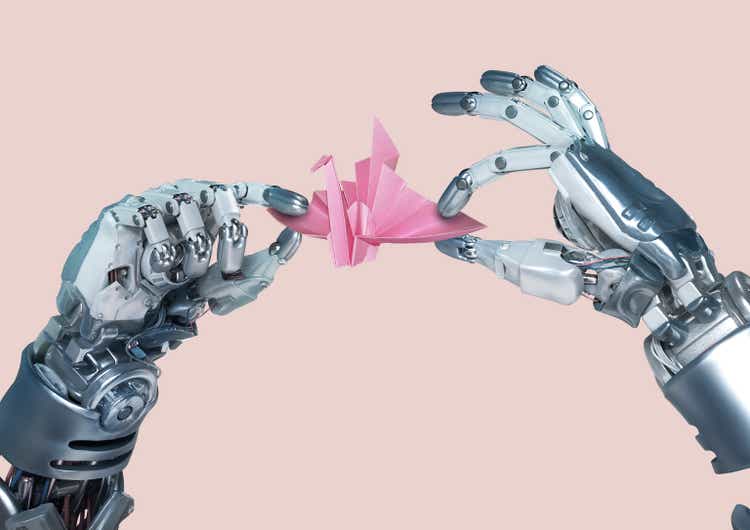Paper Boat Creative/DigitalVision via Getty Images
The dream of humanoid robots has been a visceral part of the human consciousness for decades. For many years robots depicted as either friends or foes have played a material role in film, literature, and art. Whether it’s the T-800 hunting down the last redoubts of humanity or Rosey the Robot from the Jetsons doing chores around the house of her human owners to free them from the burden of mundane and repetitive manual labour.
This future has for too long remained science fiction, the moonshot dream of a fringe number of scientists and failed startups. Hence, when Tesla (NASDAQ:TSLA) announced the Optimus Robot on its AI day two weeks ago many reacted with heavy scepticism. Indeed, Tesla has a long history of overpromising and underdelivering from full self-driving to robot taxis. Both of these have yet to become a reality. However, the Austin, Texas-based company also has a strong history of innovation despite doubts.
Optimus has been in development for only a few months and the robot is already able to stand freely and was shown watering plants and performing some tasks at an assembly line at a Tesla gigafactory. Tesla anticipates manufacturing millions of these robots within three to five years at a price of around $20,000 each. Their arrival would form a step change for humanity and would be the first time in human history of any such product being provided to households. It would usher in a new category of products and would have an impact on human civilization in ways not yet known.
Future adopters will be receiving an asset that is able to perform repetitive and dangerous manual tasks that will free them to conduct other higher-value add activities. The sky really is the limit for this and the potential total addressable market cap is material and potentially in excess of Tesla’s current automotive business. Indeed, Elon stated that the robot business will one day be worth more than its cars.
Why You’ll Buy An Optimus
Bears would be harsh but somewhat right to state that Elon Musk has historically made statements that paint him out to be a man of great hype. The lacklustre enthusiasm from the stock market and from Tesla’s own shareholders after AI day perhaps reflects an expectation that Optimus will stay as fiction for far longer than the current five-year roadmap to start deliveries. The challenges with developing humanoid robots are pertinent and somewhat insurmountable in this decade according to some analysts. Honda’s (HMC) Asimo, first created at the turn of the new millennium and in development since the 1980s was retired four years ago. Although not intended for the mass market, its failure despite decades of development underlies the challenge Tesla will face with its Optimus.
But you’ll want an Optimus once they arrive. The maths is simply ridiculous. For example, the average American will spend 30 long days a year carrying out chores. Hence, with the average monthly earnings for salaried US workers at around $4,466, Optimus would have a payback period of around 4.5 years if the robot is able to fully conduct all normal household tasks. Elon anticipates that the Optimus will be used in homes for making dinner, caring for the elderly, and doing household chores.
This value proposition is boosted further when you consider the opportunity cost of completing tasks that Optimus will end up doing. This can be invested in more value-accretive activities that boost earnings or from which the owner derives greater satisfaction. Whether writing a book, making music, or attending an art gallery. That’s why estimating an end total addressable market presents difficulties, the Optimus would facilitate a drastic expansion of productive capacity by ushering in a new age of unhindered near unlimited 24/7 labour. It would free its owners from the mundane and leave them free to chase their full potential.
The 161 lb Optimus will fully be developed using Tesla components including a 2.3 kWh battery pack carried in its torso which will last for a full day of work. With the short payback time, the company stands to sell millions of units per year at the current $20,000 unit price. I anticipate add-ons for extra features that would likely inflate this price to bring in more revenue for Tesla.
A Future Of Abundance
Building a human-like robot with fully versatile opposable thumbs that can delicately navigate and manipulate different objects in its environment will be very hard. But the robot, named after the powerful and kind leader of the Autobots in the Transformers movie franchise, represents a stretch goal and a huge technology leap.
The current five-year timeline until deliveries begins might in classic Tesla fashion prove too ambitious. Patience is key for a technology that is transformational to human civilization as we know it.
Hence, it’s understandable that Tesla bears have stated that the Optimus will remain a faraway dream always beyond the horizon and forever away from the reach of Tesla’s engineers. But that Tesla dares to venture into the unknown against its detractors is why the company has been so successful. The saying that the future belongs to those who dream applies here.
The Optimus is a moonshot goal for relatively little capital expenditure that if successful would catalyse a materially outsized revenue ramp and significant return on investment for Tesla. Whatever position you take, Tesla is positioning itself to no longer be just an EV company. The implications for shareholders and the world whilst not clear now will be entirely transformative.


Be the first to comment